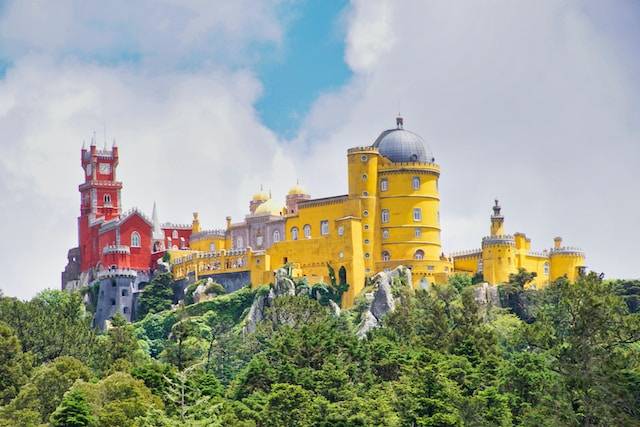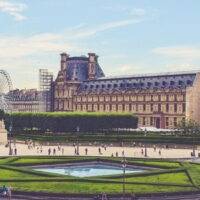Best Portugal Itinerary – 7 days from Lisbon

Last Updated on July 14, 2024
Planning a trip to Portugal and wondering what to do for a week there? If you’re flying in and out of Lisbon here’s the perfect 7-day itinerary. Explore some of the best destinations in Portugal, discover the country’s unique culture and traditions, and indulge in some tasty local delicacies.
Keep on reading to discover the best 7-day Portugal itinerary from Lisbon!
HELPFUL WEBSITES TO HELP YOU PLAN YOUR TRIP
HELPFUL WEBSITES TO HELP YOU PLAN YOUR TRIP
Disclaimer: This post contains affiliate links, which means that if you click on any links and make a purchase, we’ll get a small commission, at no cost to you.
Day 1: Lisbon
Recommended hotels in Lisbon ↗

Ahead lies an exciting adventure in one of Europe’s most captivating countries. Portugal, with its rich history, enchanting landscapes, and cosmopolitan cities, has something for every traveler.
Day one of your journey begins in Lisbon, the capital city that effortlessly blends traditional charm with contemporary cool. The city is a pastel-colored delight, with tile-adorned facades and narrow alleyways that reveal something new at every turn.

Start your exploration at the historic Belém Tower. This UNESCO World Heritage site dates back to the 16th century and stands as an emblem of the Age of Discovery. The tower, built in the Manueline style, is a wonder to behold, as it emerges stoically from the banks of the Tagus River. A tour inside the fortress is a step back in time, offering insight into Portugal’s maritime history and its connections to the wider world.
Just a short walk away is the Jerónimos Monastery. Another testament to the Manueline architecture, the monastery is a marvel of ornate arches and intricate carvings that reflect Portugal’s era of exploration. Don’t miss the chance to visit the serene cloisters and the church, where the tomb of the famed explorer Vasco da Gama resides.
After a morning absorbed in history, take a short detour to the famous Pasteis de Belém bakery, where you can see the legendary pastel de nata being made. This traditional Portuguese custard tart, with its creamy filling and flaky crust, is an essential part of any Lisbon experience. And you can enjoy a vegan option at Vegan Nata in the Chiado neighborhood!
In the afternoon, head to the Alfama district. This is Lisbon at its most authentic. As you wander the labyrinthine streets of the city’s oldest neighborhood, you’ll hear strains of Fado music wafting from hidden taverns. The soulful tunes, declared a part of the world’s intangible cultural heritage by UNESCO, provide a soundtrack to the tales of love and loss that the city has witnessed over the centuries.
Alfama is also home to the São Jorge Castle. A journey up to this hilltop fortress rewards you with panoramic views of Lisbon’s red rooftops, the sparkling river, and the distant Atlantic.
As the day winds down, find a miradouro (viewpoint) and join the locals in one of their favorite pastimes – watching the sunset while sipping on a glass of vinho verde.
For great dining options, check out AO 26 – Vegan Food Project or enjoy tapas at The Food Temple.
Lisbon is a city that invites leisurely exploration. Its mix of monuments, vibrant neighborhoods, and culinary delights offers a full and satisfying first day of your 7-day tour. Rest assured that this is just a taste of the cultural feast that Portugal has in store for you.
Over the next six days, as you journey through the towns of Sintra, Coimbra, and Porto, prepare to be enchanted by Portugal’s distinctive allure. So, let’s raise a toast to the start of an unforgettable journey. Saúde!
Day 2: Sintra (Day trip from Lisbon)

Sintra, situated within the hills of the Serra de Sintra, is an enchanting town near Lisbon, Portugal. Its fairytale-like setting, rich history, and distinct architectural styles make it a unique and highly recommended place to visit.
A 40-minute train ride from Lisbon will take you to this UNESCO World Heritage site known for its stunning palaces and beautiful landscapes.
The cultural landscape of Sintra, including its historic town center and several royal estates, castles, and buildings spread throughout the surrounding hills, is recognized as a UNESCO World Heritage Site.
Don’t miss the flamboyant and colorful Pena Palace, one of the finest examples of 19th-century Romanticism in the world. It’s perched on a hilltop, providing stunning views of the area.
Next, the Moorish Castle, or Castelo dos Mouros, is a medieval castle ruin with fantastic views over the surrounding forests and the sea. It’s a testament to the region’s early history, dating back to the 8th-9th centuries during the period of Muslim Iberia.
For lunch, check out the popular Incomum by Luís Santos.

In the afternoon tour the Quinta da Regaleira. This early 20th-century Gothic mansion is surrounded by an extensive garden filled with grottoes, fountains, tunnels, and underground caverns. The initiation well, which was used for Masonic rites, is a particularly intriguing feature begging to be photographed.
Then head to the National Palace of Sintra. Located in the town center, this palace is distinguished by its dramatic twin chimneys. It contains exceptional examples of Moorish and Manueline-style decorations.
Nearby, the Sintra-Cascais Natural Park is a vast and beautiful landscape with forests, cliffs, and beaches. You can hike, bike, or take a leisurely stroll to enjoy the area’s natural beauty.
Overall, Sintra is an enchanting and culturally rich destination that offers a unique blend of natural and architectural beauty, making it a must-see for any visitor to Portugal. And it is close enough to the city that you can treat this as a very special day trip and return to Lisbon that evening.

If Sintra does not sound like a fit then consider a day trip from Lisbon to the beaches of Cascais as a valid alternative. Situated on the coast just beyond Lisbon, Cascais is a wonderful retreat if you need a day to relax and enjoy the sounds of the waves. Be sure to check out the House of Wonders when you are hungry!
Day 3: Porto

Let’s continue our captivating journey through Portugal, heading to the enchanting city of Porto. After soaking up the history and culture of Lisbon, it’s time to venture northward. Roughly a 3-hour trip traveling by train, you’ll find yourself immersed in the varied landscapes of Portugal – from rolling hills to scenic coastlines.
Upon arrival, you’ll immediately notice the distinct charm of Porto. This is a city where age-old traditions blend seamlessly with a vibrant contemporary culture, creating a unique atmosphere that’s both welcoming and intriguing.
Your exploration can start at Avenida dos Aliados, the city’s main boulevard. Lined with grand buildings, including the city hall, it’s a testament to Porto’s prosperous past and dynamic present. Cafés and restaurants spill onto the pavements, inviting you to pause for a leisurely meal or a cup of coffee.

Next, wander towards the Ribeira district, the city’s historic heart and a UNESCO World Heritage Site. The area is a maze of narrow, winding streets and colorfully tiled old houses that cascade down towards the River Douro. The riverside promenade is a lively place, where locals and tourists alike gather to enjoy the views and the bustling atmosphere.
While in the Ribeira district, take the time to cross the Dom Luís I Bridge. This double-deck iron bridge is an iconic symbol of Porto, offering panoramic views of the city and the Douro River. Walking across it is an experience you won’t want to miss.

Porto is also known for its impressive churches and cathedrals, each a testament to different periods and styles of architecture. Visit the Porto Cathedral, one of the oldest buildings in the city, to admire its Romanesque roots and later Gothic and Baroque additions. Nearby, the Church of São Francisco is worth a visit for its lavish Baroque interior.
If you have time (and energy), the Serralves Museum and Gardens is an excellent place to appreciate contemporary art and take a peaceful stroll. It’s a bit of a detour from the city center, but well worth the trip if you’re a lover of art and beautifully landscaped gardens.
As the day draws to a close, remember to try some of the local dining options in Porto. These include a buffet-style dining option at DaTerra and for a bit more of your budget, a meal at Em Carne Viva.
This is just the beginning of your Porto adventure. With its friendly people, rich history, and amazing architecture, the city has much more to offer in the days to come. Get ready to dive deeper into the unique charm and character that is quintessentially Porto.
Day 4: Douro Valley (Day trip from Porto)

Just a short journey from Porto, you’ll find the romantic Douro Valley, a region that offers an irresistible blend of beautiful landscapes, cultural heritage, and delightful gastronomy.
The Douro Valley is one of the oldest demarcated wine regions in the world, globally renowned for its Port wine and high-quality table wines. But this region offers far more than its prestigious vintages. The entire area is a UNESCO World Heritage site, testament to its cultural significance and natural beauty.
The landscape of the Douro Valley is destination worthy all on its own, with steep terraced vineyards carved into the hills, overlooking the meandering Douro River. Every turn in the road reveals another vista that makes you consider moving here for the long term. This is a paradise for photographers and nature lovers alike.
Many of the quintas (wine estates) dotted throughout the valley have been family-run for generations, and a visit often includes local insights into the region’s rich history and wine-making traditions.

In addition to its vinicultural charm, the Douro Valley also offers a taste of Portugal’s rural life and traditions. Charming villages and towns like Peso da Régua, Pinhão, and Lamego offer opportunities to explore historic sites, local markets, and traditional restaurants.
I highly recommend a Douro Valley Tour that includes round-trip private transportation, a river cruise, lunch (vegetarian and vegan meals can be scheduled in advance), and a wine tour.
Day 5: Coimbra
Recommended hotels in Coimbra ↗

Say goodbye to Porto and begin your southern return with a trip to Coimbra, a medieval city known for its university, one of the oldest in Europe. Explore the University’s stunning library, the Joanina Library, and the Old Cathedral of Coimbra.
There are also a few high-quality restaurants in Coimbra such as Greenside and Fangas Veg.

Start your day exploring the University of Coimbra. Established in 1290, the University of Coimbra is one of the oldest universities in continuous operation in the world, and the oldest university of Portugal. It’s a UNESCO World Heritage site, and its stunning architecture, including the iconic University Tower, the Joanina Library, and the St. Michael’s Chapel, are a delight for visitors.
Coimbra served as the capital of Portugal until 1255, and the city’s historic buildings and winding streets are a testament to its past. The Old Cathedral (Sé Velha) and Santa Cruz Monastery are especially worth a visit.

Downtown Coimbra, particularly the Baixa district, is an active area with numerous shops, cafes, and bakeries. Here you can enjoy people-watching and soak in the local culture.
Coimbra is situated by the Mondego River, and the city’s terraced gardens and parks offer tranquil spaces to relax. The Botanical Garden of the University of Coimbra is a particularly beautiful spot.
Coimbra is also known for its unique style of Fado, a traditional form of Portuguese music that is deeply emotive and often associated with longing, fate, and love. Coimbra’s Fado is typically associated with academic tradition, and performances often take place in old, atmospheric venues.
If you have some time left, just south of Coimbra, you’ll find one of the best-preserved Roman sites in Portugal, Conímbriga. It has well-preserved mosaics and the ruins of an ancient Roman city to explore.
Visiting Coimbra allows one to step back in time and enjoy the city’s historic charm, academic heritage, and vibrant cultural scene. It’s a city that has something to offer everyone, making it a must-visit location in Portugal.
Day 6: Fatima
Recommended hotels in Fatima ↗

Next, head to Fatima, a town located in central Portugal that holds significant importance for many Catholics worldwide.
Fátima is renowned as a major pilgrimage site due to the events of 1917 when three shepherd children reportedly witnessed apparitions of the Virgin Mary, also known as Our Lady of Fátima. These apparitions occurred on the 13th day of six consecutive months, starting in May and ending in October.
The messages delivered during these apparitions, known as the “Three Secrets of Fátima,” have been interpreted and speculated upon by many and continue to inspire the faithful.

In town, visit the Sanctuary of Our Lady of Fátima, one of the largest Christian shrines in the world. The vast esplanade is dominated by the Basilica of Our Lady of the Rosary, where the tombs of the three shepherd children, Francisco, Jacinta, and Lúcia, are located. Across from the old basilica is the modern Church of the Holy Trinity, one of the largest Christian churches in the world.
Fátima is famous for its nighttime processions where pilgrims gather with candles, creating a sea of soft light. These processions occur regularly and are especially impressive on the anniversaries of the apparitions.
The Chapel of the Apparitions is also worth checking out. This small chapel was built at the site where the Virgin Mary is said to have appeared to the three children. It’s a simple structure, and a single statue of the Virgin Mary marks the spot where the apparitions are said to have occurred.

Beyond the religious significance, Fátima is a place of peace, reflection, and spirituality. Whether or not one is religious, the tranquility of the place, the faith of the pilgrims, and the overall atmosphere can be a unique experience.
Additionally, Fátima’s central location makes it a good base for exploring other cultural sites in the region. The nearby medieval town of Tomar, the Monastery of Batalha, and the picturesque Nazaré beach are all worth visiting.
Keep in mind that while Fátima is indeed a special place to visit, its appeal is largely tied to its religious significance. For those interested in history, religion, or spirituality, it can be an incredibly moving and fascinating place to visit.

If Fatima does not appeal to your interests then consider a return to Lisbon at the end of day 5 and spending day 6 on a day trip to Evora as a valid alternative. Located in the Alentejo region, Évora is a UNESCO World Heritage site with Roman ruins, a cathedral, and a chapel made entirely of bones.
Day 7: Lisbon
Return to Lisbon, taking your time to explore any areas you missed on your first day. Spend the evening in a Fado house, like Mesa de Frades where they serve plenty of food options, and enjoy traditional Portuguese music.
If you find yourself reflecting on the week’s unforgettable experiences, don’t be surprised. From the historic streets of Lisbon and the enchanting hilltops of Sintra to the university town charm of Coimbra and the vibrant energy of Porto, Portugal has shared its rich tapestry of culture, history, and natural beauty with you. As you sit in Lisbon’s airport, waiting for your flight, you savor one last moment and promise yourself this is not a goodbye but a see you soon.

When you are ready to expand your exploration of Portugal don’t forget to visit the magical islands of the Azores! Consider a visit to the island of Sao Miguel. This is one of my favorite spots in all of Portugal and I don’t want you to miss out.
Portugal has captured a piece of your heart, and you know you’ll be back to explore even more of what this remarkable country has to offer. Here’s to your return. Até logo mais!
This article was written by Michelle Muncy-Siva, author of Travel with Intention.
Save it on Pinterest for later: Portugal Itinerary – 7 days from Lisbon
















